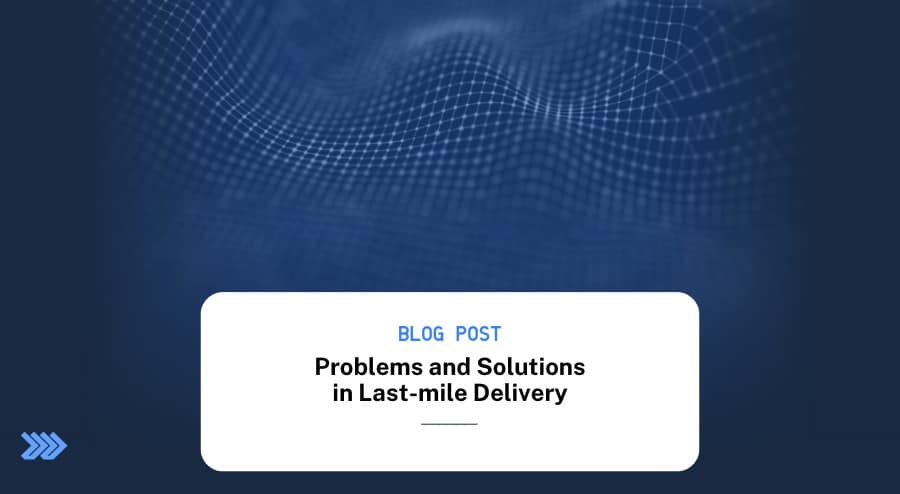Problems and Solutions in Last Mile Delivery

Wise Systems

Managing last-mile deliveries can be a nightmare for shippers, distributors, and perhaps most especially, carriers. You probably know this all too well.
You’ll face no shortage of challenges as you strive to get products into the hands of your customers, but if you rise to the occasion, you can keep your customers happy, protect your brand image, and build your business. If these last-mile delivery problems get the best of you, however, your business will struggle, and you may experience a drop in demand.
To help you avoid such outcomes, we’ve outlined four common – yet frustrating – last-mile delivery problems and how you can solve them. While many of them will likely sound quite familiar, the proposed solutions may be just the answers that have been evading you.
Understanding the Last-Mile Delivery Challenge
If you run a quick Google search of the phrase “challenges in courier industry,” one of the top results you get will undoubtedly be “last-mile delivery.” It may even dominate the entire first page of your search results, a reality that demonstrates that every courier knows that last-mile delivery is a problem. The question is why.
There’s no single answer — several factors combine to make last-mile delivery problematic for couriers and a point of frustration for customers.
However, if we have to point the finger at a single issue, it would be that last-mile delivery requires drivers to make numerous stops to drop off small package payloads. This process is inefficient, time-consuming, and tedious, and leaves room for automation and optimization.
The challenge of last-mile delivery has been exacerbated by changing customer expectations. As e-commerce shopping has become the norm, top digital retailers like Amazon have continued to increase the efficiency of their fulfillment and delivery processes and drive customer expectations in all sectors.
4 Frustrating Last-Mile Delivery Problems
Several last-mile delivery problems make it difficult for brands to adapt to evolving consumer expectations, expediently fulfill orders, and mitigate the costs of final-mile drop-offs. These include:
1. Poor Customer Communication
Customers are much more likely to be understanding of delivery delays if they’re made aware of them promptly. However, many couriers have inefficient, or sometimes nonexistent, customer communication protocols in place. Dedicated fleet managers attempt to remedy this issue by manually notifying customers, which is impractical and ineffective.
The solution to this problem is to implement a last-mile solution that allows customers to check their order status, and stay in the loop. It will also allow customers to opt-in for email or text message updates to receive prompt notice when delays occur.
Simply streamlining customer communication will eliminate much of the friction associated with last-mile delivery and help organizations protect their brand image.
2. Failed or Delayed Deliveries
Few things are more frustrating for customers than failed or delayed deliveries.
Drop-off delays aren’t just a pain point for customers — they’re also a source of irritation and expense for carriers. When drivers can’t deliver a shipment on the designated day, it has to be slotted for re-delivery, creating congestion and straining a carrier’s already overstretched resources.
To solve this problem, carriers must first determine what’s causing delivery delays. Frequently, delays and failed deliveries occur when drivers run behind schedule or the client order data and time windows are incorrect. Many circumstances can cause drivers to fall behind, but the most likely culprit is inadequate route planning. Carriers can remedy this problem by leveraging modern route optimization software.
This software plans custom routes for each driver, factoring in the numerous variables and constraints associated with each order, and also provides access to turn-by-turn directions. Cloud-based- route planning software also accounts for road closures, rush hour traffic jams, and other obstacles. These solutions promise to reduce the frequency of delayed deliveries and help carriers keep customers happy.
Using technology to plan efficient routes and respond to issues during route execution can decrease the number of failed or delayed deliveries in a day.
3. A Lack of Visibility into Assets and Resources
The absence of information about driver and vehicle or container location presents persistent headaches for fleet managers worldwide. Far too often, they resort to inefficient tactics like unsuccessfully calling and texting drivers on the road, sending text messages that frequently go unanswered, or wasting time waiting around for updates.
Premier final-mile software solutions eradicate this last-mile problem by giving fleet managers real-time insight into the location and availability of their teams and assets.
From there, they can monitor driver routes to:
- Manage exceptions quickly
- Identify potential delays
- Confidently plan routes
- Quickly assign assets to tasks during route planning or execution
Modern routing and dispatch solutions give managers the insights they need to: manage exceptions, confidently plan routes, and quickly assign tasks during route planning or execution.
4. Overwhelmed Drivers
From pedestrians to distracting car horns, hard-to-see traffic lights to lack of parking, driving city streets is already stressful. Last-mile delivery drivers have to contend with all of these stressors while also worrying about making their stops on time, taking the proper steps at each stop to meet customer requirements, and keeping their dispatchers and managers up to date.
An interactive route management app helps drivers break through the noise and focus on the job at hand with turn-by-turn navigation and access to stop details from previous runs. At the same time, the app keeps everyone up-to-date on route progress so the driver can keep their eyes on the road.
Putting route, stop, and customer information in the hands of your drivers via a clean, easy to use interface helps them stay on time, improves safety conditions, and lowers delivery costs.
Put These Headaches Behind You with Wise Systems
Solving each of these last-mile delivery problems requires a unique solution. Fortunately, all of these final-mile delivery solutions are available in a single platform.
Wise Systems’ delivery optimization platform provides you with a portfolio of solutions for fleet managers, dispatchers, drivers, and even customers. With Wise Systems in your corner, you can keep customers in the loop, optimize routes, reduce the risk of delivery delays, and gain unparalleled oversight of your fleet.
To learn more about Wise Systems and our robust last-mile delivery solutions, schedule a demo today.





